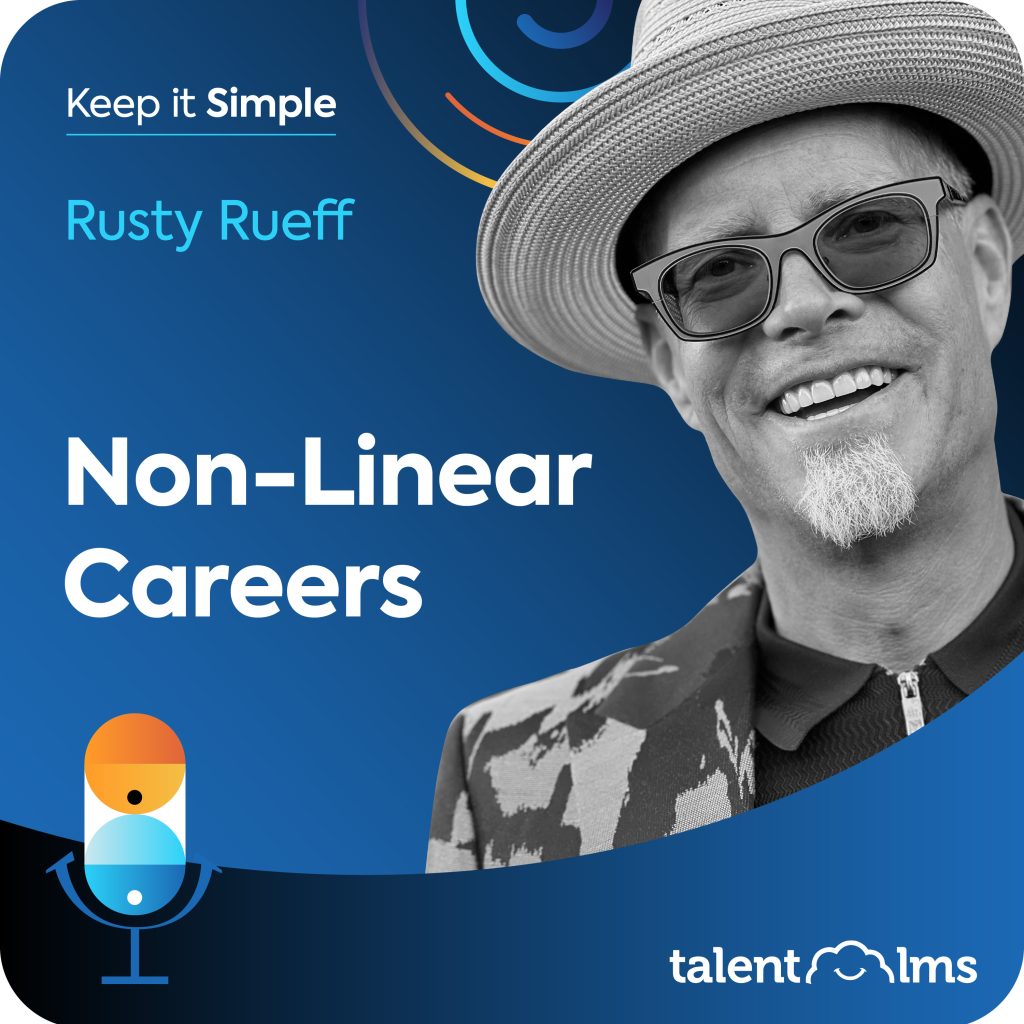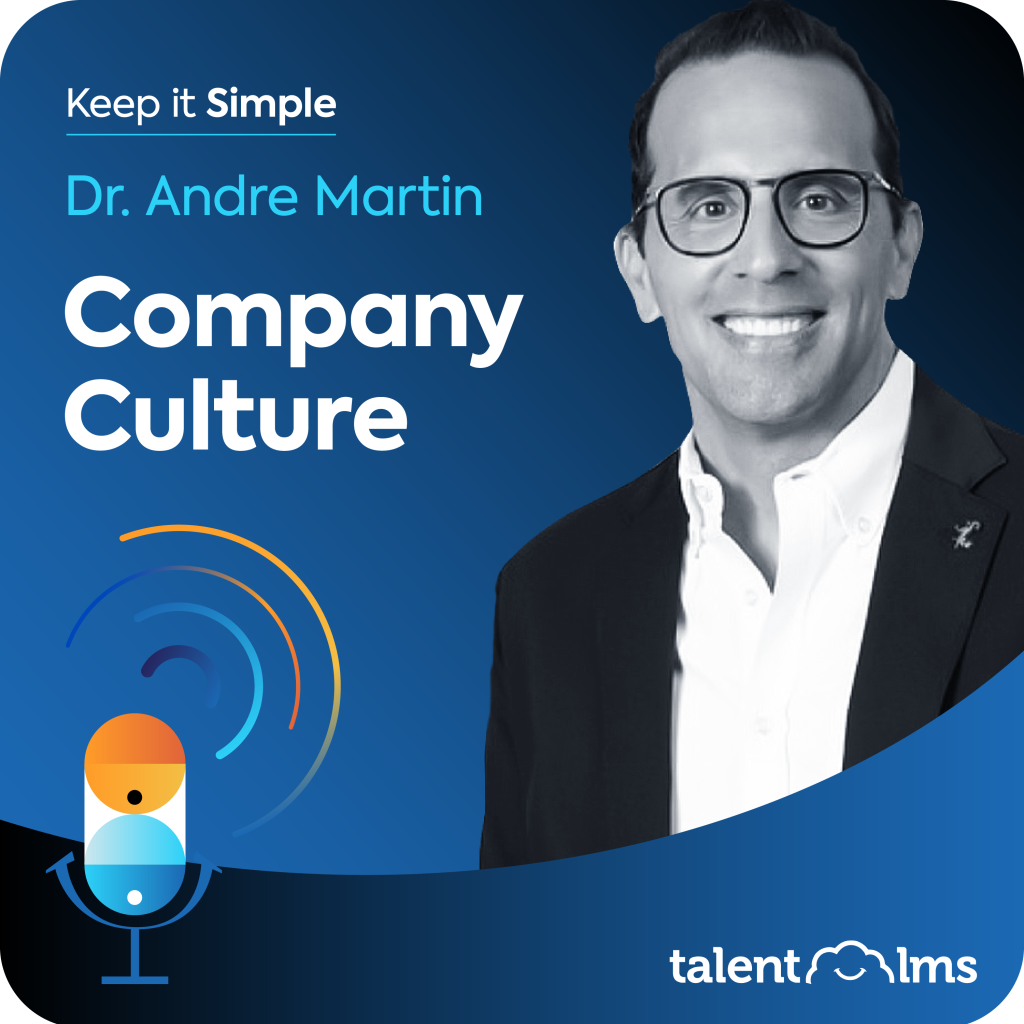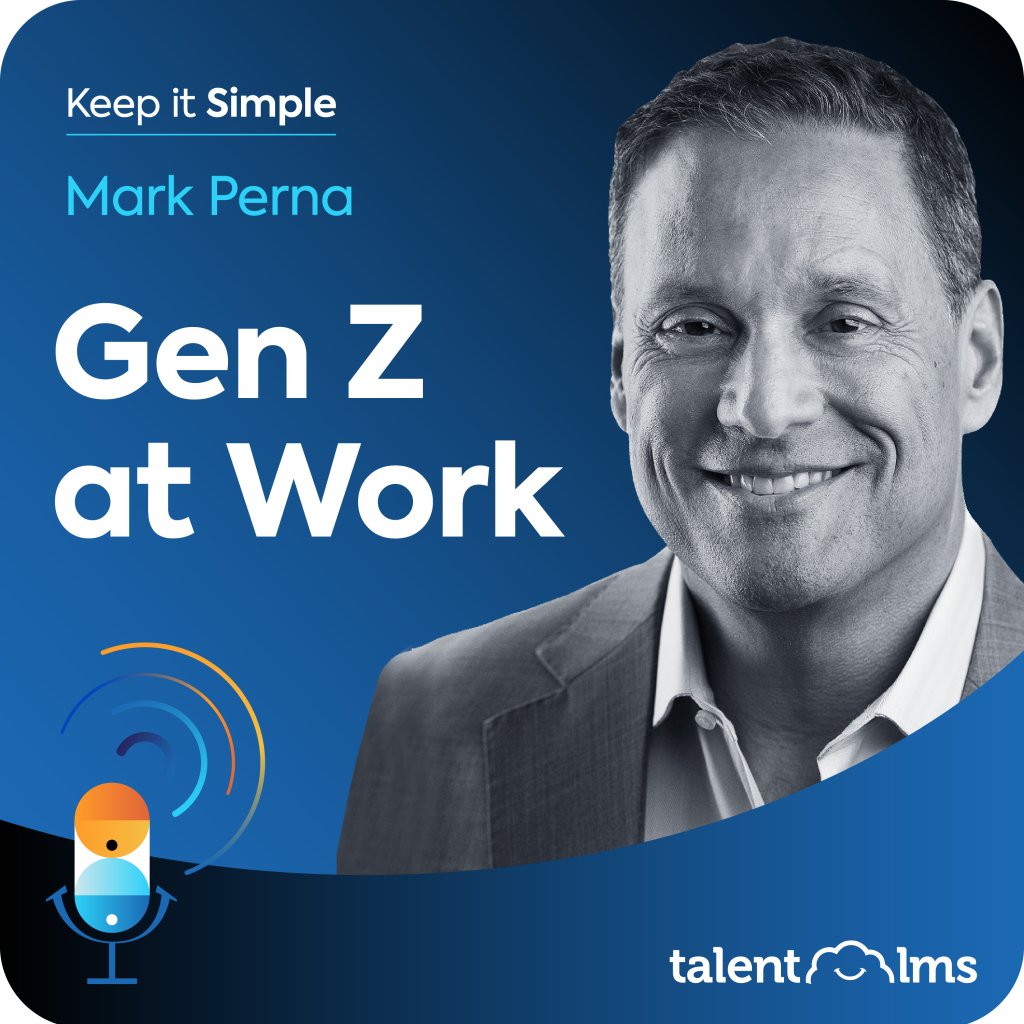Episode 14: Hiring from within: The abundant talent that’s under your nose
Duration: 32min
About our guest:

Edie Goldberg
Edie Goldberg, Ph.D. is the founder of E. L. Goldberg & Associates. She is a nationally recognized expert in HR strategy, talent management, and organization effectiveness.
She focuses her practice on designing HR systems to attract, engage, develop and retain employees. She is the co-author of The Inside Gig: How Sharing Untapped Talent Across Boundaries Unleashes Organizational Capacity
Share episode
What’s the number one strategy to tap existing skills—without spending on outside help? And are you overlooking internal talent? Edie Goldberg, consultant to Fortune 500 companies, HR expert, and author of The Inside Gig, joins us to share some insightful truths about the world of internal mobility.
Together we cover what goes into creating successful pathways for your people and how open-minded managers are the key to unlocking new opportunities for your employees—and your business.
Key takeaways:
Managers should shift from a mindset of talent scarcity to one of abundance. This means that instead of hoarding their talent, they should view all employees in the organization as potential sources of internal talent. This managerial mindset shift is vital for fostering internal mobility and collaboration.
Organizations should prioritize leveraging internal talent within their workforce before looking externally. This involves recognizing and making the most out of the diverse skills and capabilities of current employees. Through this process, organizations save time and resources and boost employee engagement and retention.
Implementing a system or tech that facilitates identifying and mobilizing internal talent is essential. A platform-supported internal talent marketplace can help match employees with projects that fit their skills and interests, promoting continuous learning and career development. However, successfully implementing an internal talent marketplace requires careful planning and change management.
Embracing internal mobility leads to more engaged and productive employees who are less likely to leave. It also creates a culture of ongoing learning and helps the company stay flexible and ready for changes in technology and business needs.
More episodes we think you’ll love

November 22, 2023 • 34 min.
•
People Management | Learning & Development
Navigating non-linear career paths
What can a jack of many trades bring to the table? Join us as we explore why ‘squiggly line’ careers are great news for both employees and employers. Alongside Rusty Rueff, who boasts experience under Obama, at Pepsi-Co, and as Glassdoor Board Director, we’re explaining what companies stand to gain from letting employees grow in a non-linear direction, instead of simply waving goodbye. Plus: Why matching skills to roles, not past job titles, is your best hiring strategy.

January 31, 2024 • 38 min.
•
People Management | Learning & Development
Defining & Decoding Company Culture
What is company culture? Is it ping-pong tables and perks? Is it the values we talk about internally? Or is it the way the company works “on a random Tuesday in October”? With experience at Disney, Nike, and Google, Talent Exec, Andre Martin joins the discussion. Join us and find out why authenticity and intention lie at the heart of a consistent culture.

February 28, 2024 • 25 min.
•
People Management | Learning & Development
Unlocking Gen Z’s potential in the workplace
What are the biggest truths and misconceptions about Gen Z in the workforce? How can managers adapt their leadership style to play to the strengths and weaknesses of the next generation? We talk to Forbes contributor and generational expert, Mark Perna, to examine how businesses can make the most out of a multi-generational workforce, why Gen Z is the ‘benchmark’ generation, and how to attract and retain the talent of tomorrow.

Never miss an episode! Get every new drop right in your inbox
Full Episode Transcript
[00:00:00] Host: Welcome to Keep It Simple, a podcast where we’re challenging business and leadership experts to cut through the noise of the corporate world and get to the bottom of what makes the workplace actually work. I’m your host, Mina Vogia. Keep It Simple is brought to you by [00:00:30] TalentLMS, the training platform built for success and designed with simplicity in mind.
[00:00:36] Together, let’s uncomplicate what makes a winning workplace. You can find out more at talentlms.com.
On today’s episode,
[00:00:48] Edie Goldberg: You need to move managers from a mindset of talent scarcity, where they kind of covet and hoard their talent to a mindset of abundance where they see all the employees in the company as a potential source for their talent.
[00:01:05] Host: In a rush to recruit externally, are we missing the magic that already exists inside our companies?
[00:01:11] From talent hoarding managers to outdated rigid structures, what’s holding our teams back from collaborating across departments? Sharing knowledge and upskilling employees at the same time. Our guest today, HR expert, Edie Goldberg is a firm believer that we need to get smarter with how we make use of the talent we already have and how cultivating a culture of continuous learning is key to that process.
[00:01:36] She’ll be sharing her 20 plus years of experience in advising companies and talking us through the steps that she lays out in her brilliant book, The Inside Gig. Stay with us.
[00:01:57] Edie, thank you so much for being with us today. How are you? How are you doing?
[00:02:01] Edie Goldberg: I’m great. I’m excited to be with you. It’s like we’re kicking off, in the taping, we’re kicking off summer and just kind of looking forward to that and everything’s good.
[00:02:11] Host: We wanted to start with a bit of a big question. Why do you think internal hiring has long been overlooked as a standard method of hiring?
[00:02:23] Edie Goldberg: I think most organizations think we’ve to bring fresh blood into the company. I mean, that’s a big part of it. We hire people in, we look at your resume. We go, oh, they have this wonderful background. They’ve done all these different things. They’re a perfect fit for this job, but look at all the other things they’ve done.
[00:02:46] And then it’s like we develop selective amnesia and we forget everything that anybody else has done. So when a new opportunity comes up or when we need a particular skill set, we forget that we might have that internally. And we assume we have to go outside to look for that. And honestly, until the recent technology innovations, we haven’t had a way to capture that.
[00:03:12] And so it’s been somewhat impractical for organizations to keep track of all the different things that people can do that are outside of the elements of their day to day job, or even part of their day to day job.
[00:03:26] Host: I really liked that you, you sort of named it selective amnesia because even if you pay attention to your employees, sometimes, as you said, it’s just so hard to keep track and sometimes you do just forget.
[00:03:41] In your book, The Inside Gig, you argue the case that now more than ever, it’s essential that organizations look first at the talent they already have. So can you paint that picture of the business landscape? What factors are at play that make looking internally an effective strategy for hiring?
[00:03:59] Edie Goldberg: First off, let’s look at our labor market.
[00:04:01] We’re in the, one of the most tight labor markets that we have ever experienced. 77 percent of companies say that they cannot access the talent that they need to execute on their business strategy. That is a big problem for us. So we’re having problems finding the talent that we need. So, our concept of the inside gig is better leveraging the talent that you already have access to rather than just trying to look outside.
[00:04:34] I think of, you know, for years and years and years, managers have this ideal concept of the employee that they want to hire, and they create this job description, they put it out there, and then that position sits unfilled for months. Month after month, because they cannot find that ideal employee.
[00:04:56] And, you know, our idea is if you break that job into a series of projects and you ask people internally, whether or not they have those skills, you’ll find that you can actually get really important business-critical work done by leveraging the talent that you have inside rather than strictly looking for an external hire.
[00:05:16] So it’s a practicality of our labor market, it’s better use of your employees. Your employees really hate it when you go outside and you hire a contractor or an employee to do that really cool new project that they don’t get to do because they’re already an employee and that’s just not fair. Like why do all the cool projects go to contractors, right?
[00:05:46] So, giving people access to opportunities that help them to learn and grow is a big part of it. The other thing is, as I mentioned, the tight labor market. We can’t get access to the skills that we need, but with the right kind of talent intelligence, we can find out who has what we call an adjacent skill, who has a skill that’s similar and can be quickly upskilled to do that kind of work.
[00:06:19] It’s like this gold mine of talent that you’re sitting on that we’re just completely forgetting that we have access to. So mine your gold to figure out who has the skills either that you need or a similar skill set that you can quickly upskill and leverage them in a whole new capacity.
[00:06:42] Host: I’m so glad you brought up reskilling and upskilling because we know that that’s what keeps companies agile. But can you also dive into the competitive advantage it offers when it comes to today’s rapid advancements in technology?
[00:06:57] Edie Goldberg: Yeah, a couple of things regarding that. One is, the biggest reason employees leave their current employer is lack of access to career growth opportunities. So employees want to learn and grow new skills.
[00:07:13] So keeping them in their job where they’re doing the same thing day after day, like putting them in their box is not what employees want. They want opportunities to flex, to learn. The advantage to the organization is also you aren’t losing talent. And turnover has a significant cost now with the advancement of new technologies, we’re just finding that skill sets are changing so quickly.
[00:07:41] So the original business case for ‘The Inside Gig’ was actually a client of mine HERE Technologies. My co-author Kelly Steven-Waiss was then the C. H. R. O. in HERE technologies and what was happening is so, and most people haven’t heard of HERE. [00:08:00] They are a location-based services company.
They’re a global company, and they provide the technology that fuels a navigation system. So, for example, they, if you have a BMW, a Mercedes or an Audi, they fuel the nav system in your car. Okay. Anyone heard of Apple carplay? So their whole ecosystem is being completely disrupted by the fact that cars now allow you to plug your phone in to do the nav system.
[00:08:32] So you don’t need their nav system. So this is a company that is having to reinvent itself. First off, High-tech company. So skill sets are constantly changing their business model, and their business needs are changing. So they had to become agile as an organization and move to where new business imperatives were going.
[00:08:54] So they needed 2 things. 1. they needed a way to upskill their employees in the flow of work because those skill sets were rapid-fire changing in the tech industry, and the other was that they had to be really agile as a company and understand what their clients needed and understand the business environment and where they needed to shift their talent from a strategy perspective, and they needed a way to know who had what skills so that they could move people to those projects that were of [00:09:30] pressing business priority. So that’s how the whole internal talent marketplace idea came about. We were trying to solve a very specific business problem. It turns out HERE technologies is not alone. And we were incubating this idea back in 2016, really before. any internal talent marketplace existed.
[00:09:54] All the companies that I was interviewing were [00:10:00] putting together their own systems to do this, but now these technologies they’re everywhere. Every time I turn around, there’s a new talent marketplace technology. The idea of being able to uncover the skills that you have within your company so that you can better utilize that talent where you need it as a business, that is mission-critical today.
[00:10:27] Host: I’m really happy that you also brought up, uh, a couple of real life examples. It’s what I found really interesting with your, your body of work and your book. So I do want us to use that to talk about the key elements that companies you think should consider before attempting an internal mobility strategy because it’s it’s daunting.
[00:10:50] It’s scary. So where where could they start?
[00:10:54] Edie Goldberg: Yeah, it’s really important. A lot of HR [00:11:00] practitioners, and I’m recalling back to a conversation I had with a head of talent at Bayer, said, you know, Edie, my colleagues and I are really interested in this idea. We think it sounds fascinating. We know it solves a lot of our problems, but I can’t sell it to management.
[00:11:16] How do I make that business case? So we have been, or I have been, you know, sharing that data of, you know, HERE technologies we looked at. [00:11:30] If you only counted kind of compensation dollars from people who are working on projects outside of their P& L, so Edie in HR was working on a marketing project.
[00:11:43] When they look at the number of hours their employees were putting in on their talent platform, they were able to save 14 million in the first year by leveraging their own internal [00:12:00] talent rather than hiring new employees or hiring contractors. That is a compelling business case. So number one is build a business case so that leaders understand the business value of doing this.
[00:12:15] Number two is you have to implement the process. You need to find a technology that allows you to do this. And the most important part is managing the change because this changes the [00:12:30] mindset of how work gets done. You need to move managers from a mindset of talent scarcity, where they kind of covet and hoard their talent to a mindset of abundance, where they see all the employees in the company as a potential source for their talent.
[00:12:48] So working through that thought process and bringing managers along on the journey, communicating to them what’s in it for me [00:13:00] is really important. So, you know, what I recommend my clients is that you conduct an organization readiness assessment so that you really understand what those friction points are within the organization.
[00:13:14] We don’t operate like this today. We’re stuck in a job and what does it mean to let people opt in to taking on project-based opportunities? I’m not talking about leaving your job [00:13:30] at all. I’m talking about just making room for a project that taps into your passion, that helps you learn a new skill, that lets you use a skill that you have that you don’t use in your day to day job.
[00:13:44] And then, You know, kind of understand where your systems and processes kind of get in the way of that and then create a change management plan that will help smooth the road, if you will, for getting that [00:14:00] done what people fail to realize and what unfortunately I see a lot of technology companies that have this kind of technology, they’ll say, we’ll just implement it and you can turn it on.
[00:14:15] It’s super easy. It’s non disruptive. It’s hugely disruptive. And so success sits within a great change plan.
[00:14:28] Host: You’ve brought up a lot of points [00:14:30] that I will definitely be bringing us back to later on because we need to dive into them. But before we do that, going back to the examples that you brought up, like HERE technologies.
[00:14:43] These were obviously success stories from companies that you’ve worked with. Can you talk to us a little bit of how you ended up fostering a workplace where internal mobility became a part of their recruitment process?
[00:14:59] Edie Goldberg: [00:15:00] The way I was brought into this wonderful opportunity was Kelly, the CHRO. She said to me, Edie, I have an idea about, you know, moving talent around the organization, and I’m going to develop the technology that’ll help us do that.
[00:15:19] But what I know is it fundamentally changes everything we do from a talent management perspective. So I need you to come in and first sell the idea to my board of directors. That was my first job. And then I need you to help me write a whole new talent operating model. What does it look like to manage talent in this new environment?
[00:15:43] Host: So, a normal Tuesday,
[00:15:44] Edie Goldberg: a normal Tuesday, we had so much fun. And what I say is, you know, Rome wasn’t built in a day. I mean, we’re not going to change everything about how you manage talent overnight. It was really important for us to strategically look at where did their talent management processes kind of provide friction points, uh, we’re recognizing and rewarding one thing and asking for another.
[00:16:12] And. You know, there were things kind of okay, but didn’t really match our future vision. So what we did was we built a 10 year roadmap. Their vision was actually managing talent across their ecosystem. So we knew that one of the first things that we had to do was change the reward system. And we needed to reinforce managers for sharing talent across boundaries.
[00:16:43] Later, companies like Dolby Technologies started doing things like rewarding managers for being net talent exporters. So, to the extent that you’re willing to develop your employees and share them with others, maybe even move them to other parts of the business, you were [00:17:00] recognized and rewarded for those kinds of behaviors.
[00:17:04] So, today, We tend to reward our managers for hoarding their talent. We tell them if an employee moves to another position, you can’t backfill that position. So we put all these systems in place that discourage that kind of talent sharing behavior. You need to look at those systems to what extent are companies encouraged to post a position internally first versus posting it externally, turns out the Human Capital Institute tells us that only 61 percent of companies have a policy that says you have to post internally.
[00:17:44] First, traditional talent management practices are very company driven, process oriented approaches to identifying and developing high potential talent. A talent marketplace is inherently, an employee-centric platform that democratizes access to experience that gives employees agency in their own career.
[00:18:13] Those systems are at conflict, and we need to figure out, you know, some companies have said we, Want to go all in on the, you know, employee free agency democratizing access to all opportunities and other companies have said, well, access to opportunities for some things, but other things we’re going to control for succession planning purposes, or, you know, specific leadership development purposes.
[00:18:44] So we have to look at those systems and understand how we manage them to work with a talent marketplace.
[00:18:56] Host: We’ll get back to our chat with Edie in just a moment, but first we wanted to share some of our top tips when it comes to internal mobility, whether you’re just getting started or have been in the game for some time, there are a few important things you can do to effectively implement internal mobility.
[00:19:15] Firstly, it’s important to have a good overview of your skills landscape. This will guide any decisions you make. Now remember, setting up a solid internal mobility program is not just about the right tools, [00:19:30] materials, and training delivery. It’s also about ensuring a smooth adoption process. You can make skills training accessible across the company instead of confining it to a specific department.
[00:19:41] Try demonstrating the benefits to employees through targeted incentives and communications. And, this is an important one, be sure to speak with senior leadership about the overall benefits and financial benefits of internal mobility such as cost effectiveness, ROI, competitive [00:20:00] advantage, and as you heard from Edie, much more.
[00:20:04] And one last thing, these are all widely applicable strategies. However, if you’re an SMB with limited resources, there are some simpler steps to get the ball rolling. You can start by creating mentorship programs, providing cross-training opportunities between departments, and you can leverage affordable technology solutions, such as TalentLMS.
[00:20:31] Edie Goldberg: One of the biggest ways that I have seen companies really shift that mindset is through storytelling. Because when we talk about internal talent mobility, career growth opportunities, it all sounds like it’s for the employee, right? I get access to learn and grow in a new way in an area that’s based on my passion or my interest.
[00:20:57] I’m opting in as an employee. [00:21:00] But we forget there’s another side of the story, which is the manager. And I love this, uh, story from one of my clients where a manager needed to build, it was a toolkit, but they had to do it in a programming language, Python, that nobody on his team used. His team was all like Java developers.
[00:21:25] And he didn’t have time or budget to go out and like [00:21:30] hire somebody who code in Python, but he had a talent platform. And so he went out with a request for people who knew how to code in Python and could help on this project. And literally within seconds was connected to like five employees across the organization who knew how to code in Python.
[00:21:48] And their managers understood the business value of creating this toolkit, which was ultimately for their customers. And so they said, yeah, you can take like 10 percent of your time to go work on this really important project for our company. And that manager said to me, you know, Edie, this project would have never gotten off the ground if I didn’t have access to this talent marketplace that helped me to quickly identify people, get access to them, and borrow them for a short period of time to deliver something I needed.
[00:22:24] So when you start telling those kinds of stories, and you help managers see, you know, you’ve got all those projects on the back burner, and you just don’t have the resources or people with the right skills to do that work. Well, you know what? With a talent marketplace, you can find those people. You can find those resources to get important work done.
[00:22:48] And that kind of unlocks something for a manager of understanding. And then we have a value that we propose in the book called you get what you give, which is in order to get talent from within your organization, you also have to be willing to give talent. So it’s a two-way street. Uh, and at first managers are like, whoa, I’m going to give my talent away, and I’m not going to get anything in return.
[00:23:14] And then I’m going to have less resources. What we have found is it actually does work the give-get. And frankly, if you’re willing to allow your employees opportunities to stretch their wings and to do other [00:23:30] things, you’re going to become a talent magnet. And you’re going to get more access to talent, not less.
[00:23:38] Host: And it’s amazing because at the end of the day, I can imagine one builds loyalty between employee and manager, the manager that encourages the employee to try something new. And it also, I would imagine, they come back with, a greater vigor to go back to what they were doing before. Cause they’ve also –
[00:24:02] Edie Goldberg: And new skills.
[00:24:02] Host: And new skills. Exactly. Exactly. Exactly.
[00:24:05] Edie Goldberg: And, you know, what people don’t talk about enough is, I think, more business acumen. I work on a project with people outside of my day to day team. I understand more what’s going on within the organization. I understand how my work sits within a broader context, and that actually helps me add more value down the line.
[00:24:32] Host: Exactly. Now, I do want us to talk about something that can be a little challenging. Are there concerns that there might be a lack of diversity or perhaps a question of scalability when it comes to hiring from within?
[00:24:46] Edie Goldberg: I love this question. I refer to these Talent Marketplace platforms as equal opportunity platforms.
[00:24:56] Previously, the people who got access to the cool projects were all the people who are politically connected. And no offense to the white men out there, but they tend to all look like the senior leadership team who tend to be white men. And that’s not exclusively true, but they look and act much like the majority group within the company.
[00:25:20] When you democratize access to opportunities and you connect people based on the skills that they have or their interest in learning something new, you actually create an equal opportunity platform for people to get access to those opportunities. So I think, you know, a lot of diversity programs are all about training and awareness, and that’s nice.
[00:25:51] But I don’t think that’s very effective. I think you need systems that create equity within the organization [00:26:00] and this kind of platform that provides visibility, equal visibility to everybody about opportunities that are available, and then employee agency to be able to like kind of figuratively raise your hand to say that you’re interested in that.
[00:26:17] I think that is the type of system of practice policy that helps build equal opportunities within organizations. And we even have research results in terms of women’s access to opportunity. Some research from Cornerstone and Lighthouse Research Group said that women were 50 percent more likely to say that they didn’t have visibility into opportunities within their organization.
[00:26:47] But when you look at the results from companies like Schneider Electric or Unilever and how they’ve used their systems, they have a majority of women opting into these opportunities. So. More women were getting access to opportunities that helped to lift them up and advance their careers.
[00:27:11] Host: Do you think there’s a way to also ensure this?
[00:27:15] It’s great that they have access, but then to ensure things from the other side, from the selection side?
[00:27:22] Edie Goldberg: I think that companies that put a really, really rigorous selection process into their gig platform will be buried under the weight of the system. I mean, it’s got to be alive. These are already your employees.
[00:27:37] They’re volunteering for these projects. So I think I caution companies about having too much rigor, but I also encourage them to value diversity of thought, of experience, of perspective. I think that the seed should be planted in the minds of managers. The opportunities that we give people to learn and grow on projects that are outside of their day to day job fuel their career success.
[00:28:11] If we don’t provide equal access to those kinds of opportunities. We shoot ourselves in the foot.
[00:28:18] Host: I did want to ask ,when it comes to measuring, how well a program is working. What kinds of data should companies be looking for?
[00:28:27] Edie Goldberg: The most important thing for me are the [00:28:30] business outcome metrics that people are measuring against.
[00:28:34] Employee engagement. We know that employees who are engaged are more productive. If we can have a positive impact on employee engagement, we know we’re increasing productivity. And this is one of the central theses Kelly and I had when we were writing the inside gig is that if you look at the engagement numbers, they’re really super low.
[00:28:58] And so we know that when employees are doing something that they’re passionate about, right, we get in the flow, we lose all sense of time. We’re more productive. If we can give employees opportunities to do more of that kind of work, they can be more productive. And we’ve actually seen that borne out in a number of companies that have increased employee engagement and productivity, uh, within their organizations.
[00:29:25] So looking at employee engagement, I think it’s really important.
[00:29:29] Host: I really appreciate the fact that you made this complex topic seems sort of digestible. I really admire that. And to sort of close off our time together, we have one final question for you, which is usually the most challenging one. So I apologize in advance, but in one sentence, how can we keep it simple when it comes to internal mobility?
[00:29:55] Edie Goldberg: Just think about unleashing the capability that you have [00:30:00] inside. Don’t make it about politics. Don’t make it about policy. Don’t over engineer. That is my biggest thing. You want to keep it simple, don’t over engineer it.
[00:30:15] Host: Amazing. Edie, thank you so much for your time today. I’m looking forward to the work that you’re doing and what’s going to come next.
[00:30:24] I hope internal mobility becomes the new frontier.
[00:30:28] Edie Goldberg: Absolutely. You know, we wrote [00:30:30] this book with a mission to change the way we work, and that’s the what we hope, uh, will take hold. We really think that there are wonderful opportunities for everyone. It’s a win-win for companies, for managers, and for employees.
[00:30:46] And so I really hope people do consider implementing an internal talent mobility solution and you know, I’m here to share my knowledge and experience to help work company thrive in that future of work. And so go forth and explore.
[00:31:09] Host: Thanks for tuning in. In the next episode, we’ll be looking at why L&D is fast becoming a business priority. You can find Keep It Simple on all podcast platforms. Be sure to subscribe so you don’t miss an episode. This episode of Keep It Simple was brought to you by TalentLMS, the training platform built for [00:31:30] success and designed with simplicity in mind.[00:31:32] For more resources on today’s topic, visit talentlms.com/podcast.

Train your people. Measure results. Drive growth.
TalentLMS gives you the tools to supercharge every step of your training.





